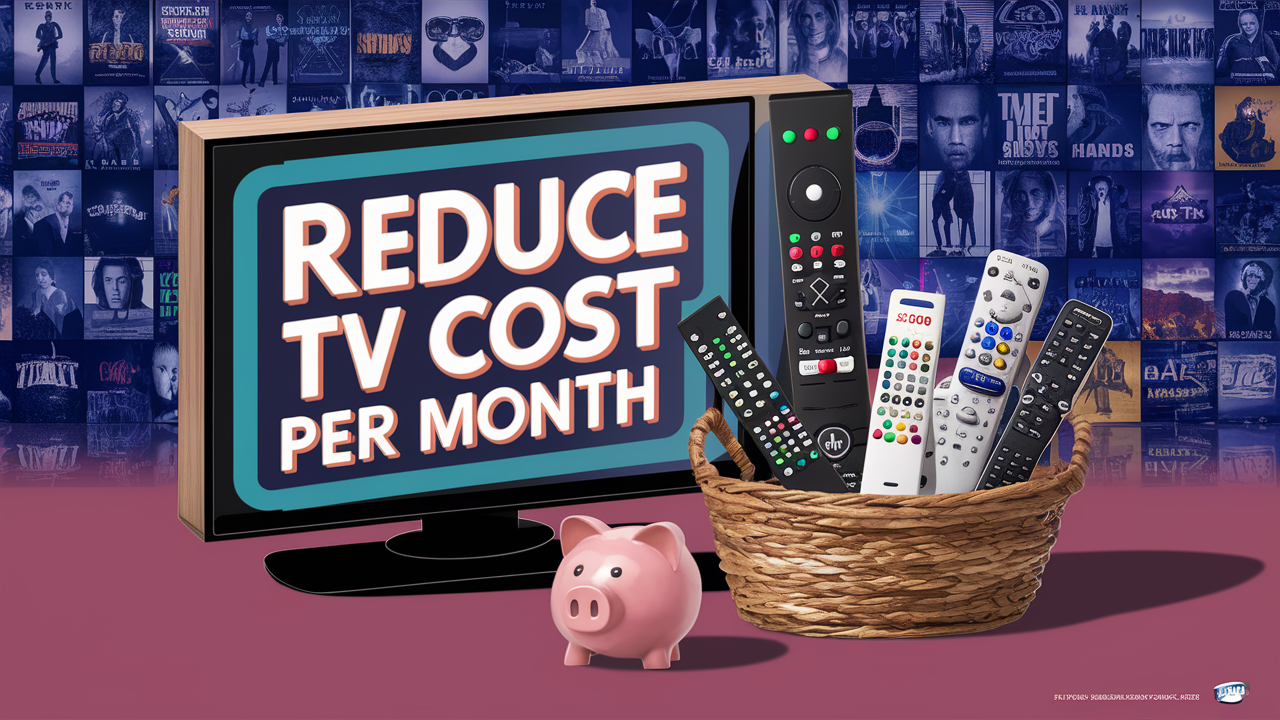Guide for select the Best Cable TV Provider in Your Area

Selecting the best cable TV provider in your area can feel overwhelming with numerous options and complex packages. This comprehensive guide will demystify the process, empowering you to find the perfect service that balances features, cost, and reliability for your household's entertainment needs.
Understanding Your Entertainment Needs
Before diving into the vast ocean of cable TV providers, the most crucial first step is to thoroughly understand your household's unique entertainment requirements. This self-assessment will act as your compass, guiding you toward the services that genuinely align with your viewing habits and budget. Ignoring this foundational step often leads to overpaying for channels you never watch or, conversely, subscribing to a package that leaves you wanting more.
Assessing Viewing Habits
Take a moment to reflect on what your family actually watches. Do you have avid sports fans who need access to every major league game? Are there children in the household who rely on specific educational or cartoon channels? Perhaps you're a cinephile who craves premium movie networks like HBO, Showtime, or Starz. Or maybe your viewing is more casual, focusing on news, basic network channels, and a few popular entertainment stations.
Consider the following questions:
- What are the top 5-10 channels your household watches most frequently?
- Are there any specific sports leagues or teams you follow religiously?
- Do you subscribe to or wish to subscribe to premium movie channels?
- Are there children's programming needs to consider?
- How important are live news channels to your daily routine?
- Do you enjoy international channels or specialized programming (e.g., cooking, history, documentaries)?
Determining Your Budget
Cable TV costs can vary dramatically. It's essential to set a realistic monthly budget. Remember to factor in not just the advertised monthly subscription fee but also potential installation charges, equipment rental fees, taxes, and any other surcharges that providers often include. According to recent 2025 industry reports, the average monthly cost for cable TV in the United States hovers around $100-$120, but this can easily escalate with premium channels and higher-tier packages. Be honest about what you can comfortably afford without straining your finances.
Considering Simultaneous Viewing Needs
If multiple people in your household want to watch different programs at the same time, you'll need to consider how the provider handles this. Most cable packages allow for multiple TV connections within a home, but there might be limitations on simultaneous live streams or DVR recordings. If simultaneous viewing is a high priority, you might need to inquire about multi-room DVR services or additional set-top boxes, which can add to the overall cost.
Researching Providers in Your Area
Once you have a clear picture of your needs, the next step is to identify which cable TV providers actually serve your specific geographic location. The availability of providers is highly localized, and what might be a top contender in one city could be non-existent in another. This research phase is critical to avoid wasting time on services you can't access.
Utilizing Online Availability Tools
The most efficient way to determine provider availability is by using online tools. Most major cable companies and reputable third-party comparison websites offer tools where you can simply enter your ZIP code or full address to see a list of available services. These tools are invaluable for quickly narrowing down your options.
Look for tools on the official websites of:
- Comcast (Xfinity)
- Charter Communications (Spectrum)
- Cox Communications
- Altice USA (Optimum)
- Verizon (FiOS - where available, often fiber optic)
- Local/Regional Cable Providers
Third-party comparison sites can also be very helpful, often aggregating information from multiple providers and allowing for direct comparison of features and pricing. However, always cross-reference information with the provider's official website to ensure accuracy, as third-party data can sometimes be slightly outdated.
Checking Local Government and Consumer Websites
In some areas, local government websites or consumer advocacy groups may provide information on cable service providers and their service areas. These resources can sometimes offer insights into the history of service in your region and the competitive landscape.
Asking Neighbors and Community Forums
Word-of-mouth can be a powerful tool. Talk to your neighbors about their cable TV experiences. They can offer firsthand accounts of installation quality, customer service interactions, and overall satisfaction. Online community forums or local social media groups can also be excellent places to gather this kind of localized feedback.
Key Factors to Consider
With a list of available providers, it's time to delve into the specifics of what each offers. This involves a detailed comparison of various features, costs, and service quality. Each factor plays a role in determining the overall value and suitability of a provider for your household.
Channel Lineups and Tiers
Cable TV packages are typically structured into tiers, with each tier offering a progressively larger selection of channels. Understanding these tiers is fundamental to choosing the right package.
- Basic/Starter Tiers: These usually include local broadcast channels (ABC, CBS, NBC, FOX, PBS), a few popular national networks (like CNN, ESPN, USA, TNT), and sometimes a limited selection of other general entertainment channels. They are the most affordable but offer the fewest options.
- Standard/Expanded Tiers: These build upon the basic tier, adding more news channels, sports networks, lifestyle channels (HGTV, Food Network), and general entertainment options. This is often the sweet spot for many families.
- Premium Tiers: These include everything in the lower tiers plus premium movie channels (HBO, Showtime, Cinemax, Starz), specialized sports packages (NFL RedZone, NBA League Pass), and niche entertainment channels. These are the most expensive but offer the widest variety.
Actionable Tip: Carefully examine the channel list for each tier offered by your potential providers. Cross-reference these lists with the channels you identified as essential in your needs assessment. Don't be swayed by the sheer number of channels; focus on the channels you will actually watch. For instance, a package with 300 channels but only 20 you care about is less valuable than a package with 100 channels that are all relevant to your interests.
Pricing and Hidden Fees
The advertised price is rarely the final price. Providers often use introductory offers that expire after a set period (e.g., 12 months), after which the price significantly increases. Be sure to understand the:
- Introductory Price: The promotional rate offered for the first year or so.
- Standard Price: The price you'll pay after the promotion ends. This is often much higher.
- Equipment Rental Fees: Fees for set-top boxes, DVRs, and modems (if bundled with internet). These can add $10-$20 per month per device.
- Installation Fees: Some providers charge a one-time fee for professional installation, though self-installation might be an option.
- Broadcast TV Fees/Regional Sports Fees: These are surcharges that cover the cost of local broadcast channels and regional sports networks, and they can add several dollars to your monthly bill.
- Taxes and Surcharges: These vary by locality and can significantly increase your total bill.
2025 Insight: Expect to see a continued trend of rising cable TV prices. Many providers are focusing on bundling services to lock in customers, making standalone TV packages less attractive. Be vigilant about understanding the total monthly cost over the long term, not just the initial promotional period.
Internet Bundles and Perks
Most cable TV providers also offer internet and phone services, creating opportunities for bundled deals. Bundling can often lead to significant savings compared to subscribing to each service separately.
- Bundled Savings: Providers often offer discounts when you combine TV, internet, and sometimes home phone services.
- Internet Speed: If you bundle, pay close attention to the internet speeds offered. Ensure they meet your household's needs for streaming, gaming, and general browsing. For 2025, consider speeds of at least 100-300 Mbps for moderate use, and 500+ Mbps for heavy streaming or multiple users.
- Perks: Bundles might come with additional perks like free equipment upgrades, waived installation fees, or subscriptions to streaming services.
Example: A provider might offer a bundle of 200 Mbps internet and their Expanded Cable TV package for $130/month, whereas the same services purchased separately might cost $160/month. However, always compare the bundled price to standalone prices from different providers, not just within the same company.
Equipment Options
The type of equipment you use can impact your viewing experience and cost.
- Set-Top Boxes: These are standard for receiving cable signals.
- DVRs (Digital Video Recorders): Allow you to record live TV and watch it later. DVRs can be rented monthly, and multi-room DVRs (allowing recordings to be accessed from multiple TVs) are also available at an increased cost.
- Streaming Devices/Apps: Many providers now offer apps for smart TVs, smartphones, and streaming devices (like Roku, Fire TV, Apple TV) that allow you to watch live TV and on-demand content without a traditional set-top box. This can save on equipment rental fees.
Consider: If you're tech-savvy and prefer a minimalist setup, inquire about using your own compatible modem and router (if bundling internet) or streaming your cable channels via an app to reduce rental fees. However, ensure the provider's app functionality meets your expectations.
Customer Service and Reliability
This is often the most overlooked, yet most critical, factor. Poor customer service can turn a good deal into a nightmare. Reliability refers to the consistency of the service – how often do you experience outages or technical issues?
- Customer Service Ratings: Look for independent reviews and ratings from sources like the Better Business Bureau (BBB), J.D. Power, and consumer review websites. Pay attention to common complaints regarding wait times, issue resolution, and billing accuracy.
- Technical Support: How easy is it to reach technical support when you need it? Are they available 24/7?
- Service Outages: Research the provider's track record for service outages in your area. Local forums and community groups can be helpful here.
2025 Trend: While many providers are investing in network infrastructure, customer service quality can still vary wildly. A provider with slightly fewer channels but consistently excellent customer service and reliability might be a better long-term choice than one with a vast lineup but frequent issues.
Contract Terms and Cancellation Policies
Most cable TV providers require customers to sign a contract, typically for 12 or 24 months. Understanding these terms is vital to avoid hefty early termination fees (ETFs).
- Contract Length: Be aware of the duration of the contract.
- Early Termination Fees (ETFs): If you break the contract early, you'll likely face a fee, often prorated based on the remaining time. These can range from $100 to $300 or more.
- Cancellation Process: How easy is it to cancel service if needed? Are there specific procedures or notice periods required?
Recommendation: If you're hesitant about a long-term commitment, look for providers that offer month-to-month plans, though these may come at a slightly higher base price. Always read the fine print before signing any agreement.
Comparing Providers: A Step-by-Step Approach
Now that you understand the key factors, let's outline a systematic approach to comparing your available providers.
Step 1: Create a Comparison Matrix
Use a spreadsheet or a simple table to list your available providers and the factors you'll be evaluating. This visual aid will make comparisons much clearer.
Example Matrix Structure:
| Feature | Provider A | Provider B | Provider C |
|---|---|---|---|
| Monthly Base Price (after promo) | $XX.XX | $YY.YY | $ZZ.ZZ |
| Essential Channels Included | Yes/No (List) | Yes/No (List) | Yes/No (List) |
| Premium Channels Available | Yes/No (List) | Yes/No (List) | Yes/No (List) |
| Estimated Total Monthly Cost (with fees) | $XX.XX | $YY.YY | $ZZ.ZZ |
| Internet Speed (if bundled) | XXX Mbps | YYY Mbps | ZZZ Mbps |
| Equipment Rental Fees (per month) | $X.XX | $Y.YY | $Z.ZZ |
| Contract Length | 12/24 Months | 12/24 Months | Month-to-Month |
| Customer Service Rating (1-5) | 4.0 | 3.5 | 4.5 |
| Reliability Notes | Good | Fair | Excellent |
| Early Termination Fee | $XXX | $YYY | N/A |
Step 2: Gather Information from Provider Websites
Visit the official website for each available provider. Use their online tools to check service availability at your address and browse their package offerings. Pay close attention to the details of channel lineups and pricing structures.
Step 3: Call Providers Directly
While websites provide a lot of information, calling customer service can be beneficial. You can:
- Ask specific questions about packages and fees.
- Inquire about current promotions not advertised online.
- Get a feel for their customer service representatives.
- Clarify any ambiguities from their website.
Pro Tip: Have your list of essential channels and your budget ready when you call. Be polite but firm in your inquiries.
Step 4: Read Independent Reviews
Supplement your research with reviews from reputable consumer watchdog sites, tech review publications, and customer forums. Look for patterns in complaints or praise regarding specific providers in your region.
Step 5: Evaluate Bundles Critically
If you need internet service, seriously consider bundled offers. However, compare the total bundled cost against the cost of purchasing internet and TV from separate, highly-rated providers. Sometimes, a bundle isn't the best financial choice.
Navigating Promotions and Discounts
Cable TV providers frequently offer promotions and discounts to attract new customers. Understanding how to leverage these can significantly reduce your initial costs.
Understanding Introductory Offers
These are the most common type of discount. They typically apply for the first 6, 12, or 18 months of service and offer a reduced monthly rate. Always know when the promotional period ends and what the standard rate will be thereafter. This is a critical piece of information that can be intentionally obscured.
New Customer Deals
Providers often have specific deals for new customers, which might include:
- Discounted monthly rates
- Free premium channel trials
- Waived installation fees
- Free equipment upgrades (e.g., a free DVR for the first year)
- Gift cards or bill credits
Bundling Discounts
As mentioned, bundling TV with internet and/or phone services is a common way to achieve discounts. The more services you bundle, the greater the potential savings, although the total monthly outlay will naturally increase.
Loyalty Programs and Retention Offers
If you are an existing customer considering switching, contact your current provider and mention competitor offers. They may be willing to offer retention deals to keep your business. Similarly, if you've been a loyal customer for a long time, inquire about any loyalty discounts.
Negotiating Your Bill
Don't be afraid to negotiate. Many customer service representatives have the authority to offer discounts or promotions, especially if you're a new customer or threatening to leave. Frame your negotiation around competitor pricing or specific features you desire.
Example Negotiation Tactic: "I'm looking at a similar package from [Competitor Name] for $10 less per month. Can you match that price or offer any additional discounts to make your service more competitive?"
Making the Final Decision
After thorough research and comparison, you'll likely have narrowed down your choices to one or two top contenders. This stage involves weighing the remaining pros and cons to make your final selection.
Prioritize Your Needs
Revisit your initial needs assessment. Which provider best meets your must-have channels, budget, and viewing habits? If Provider A offers slightly better sports coverage but Provider B has superior customer service and a lower long-term price, which is more important to you?
Consider Long-Term Value
Look beyond the initial promotional period. Calculate the total cost of service over 12 or 24 months, including all fees and the standard monthly rate. A slightly higher initial price with a lower standard rate might be more economical in the long run.
Trust Your Gut on Customer Service
If you had a particularly positive or negative experience with a provider's customer service during your research, take that into account. A frustrating customer service interaction during the sales process can be a red flag for future support issues.
Review Contract Terms One Last Time
Before committing, ensure you fully understand the contract length, cancellation policy, and any associated fees. If anything is unclear, ask for clarification in writing.
The Installation Process
Inquire about the installation process. Is it professional installation only, or can you opt for self-installation? What is the typical timeframe for installation after signing up? A smooth installation is the first step to a positive customer experience.
Conclusion
Navigating the landscape of cable TV providers to find the best fit for your area requires diligence, a clear understanding of your needs, and a systematic approach to comparison. By assessing your viewing habits, researching local availability, and meticulously evaluating factors like channel lineups, pricing, hidden fees, equipment, customer service, and contract terms, you can make an informed decision. Remember to leverage online tools, ask for community insights, and don't shy away from negotiating promotions and discounts. Ultimately, the best cable TV provider is the one that offers the most value and satisfaction for your specific household, ensuring endless hours of entertainment without unnecessary frustration or expense. Take your time, do your homework, and you'll secure a service that perfectly complements your home entertainment needs for years to come.





